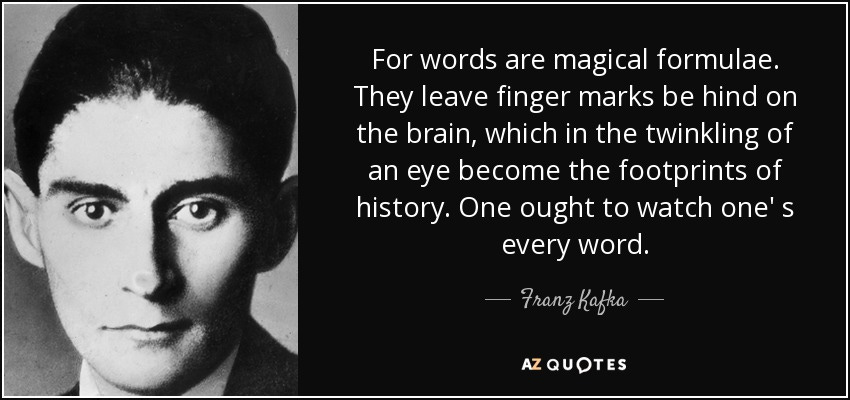Banking Tricks of the Trade: Language #1--Is Value Value?
To-two was a racehorse, Wonwone was one too. To-two won one race. Wonwone won one too...Nana, c1975.
The world of finance, money, and currency is a world of tricks. Tricks of language. Tricks of mathematics. Tricks of perception.
The ‘Value’ Language Trick
Assume you want to buy something. It’s a trustless transaction that requires immediate settlement, so the seller wants something real in return. There are only two possible settlement options. The buyer offers:
an item the seller wants now (i.e. a barter: anything—an egg, a bail of hay, some gardening, a haircut, a tonne of iron ore…there are as many possibilities as scales), or
an item the seller can use later to obtain something the seller wants. In other words, the seller wants a store of value.1
Considering only 2.
Over centuries the ‘something real‘ item, which could be used anywhere and has timeless value, was gold. Specially refined and standardized weights produced from gold and other metals, which eventually came to be called money, were made legal-tender for settlement of debt.2
So when you went to purchase something, the seller didn’t say “that will be ten grams of gold please.“ They said something else. Something like…
1…“The price is”…
2…followed by a number…
3…followed by a final word, a noun.
That noun differed depending on the time and location you were in: dollar, pound, franc, peso, ducat…there are many examples.
The key point here is :
the noun was a name used to describe a known weight of precious metal that had been minted and coined.
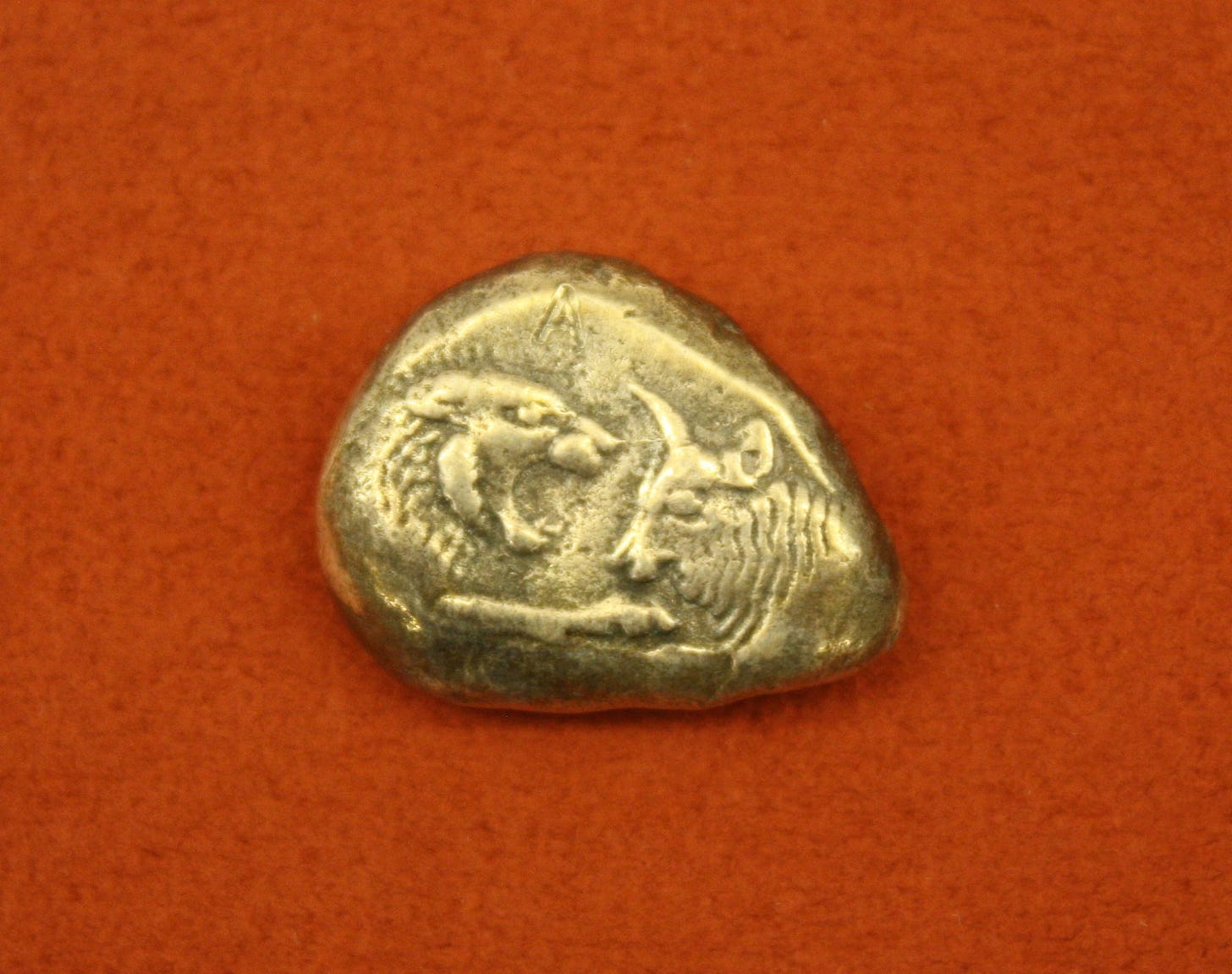
Consider ‘Sterling’
The United Kingdom’s currency and coinage, used in New Zealand until 1933/4.
Sovereign was the name of a minted legal-tender specie gold coin containing a specific weight, approximately a ¼ troy ounce, of gold. A physical thing.
A gold sovereign had a value in sterling-currency. The value was named pound, and the word ‘pound’ had a symbol, £, easier and more efficient to write and read.
The sovereign got its sterling-currency value from individual sterling-currency values (or costs = C): a weight of gold (C1) + production (C2) + legal-tender-status (C3) i.e.
C1+ C2 + C3 = £1 = one specie gold coin called the sovereign.For the purposes of accounting the symbol and value can be written in a ledger to represent the sovereign.3
Gold in the form of the sovereign coin defined the sterling-currency ‘pound’. The word ‘pound’ or its symbol DID NOT define the the sovereign coin. The key takeaway?
The word ‘pound’ and its symbol ‘£‘ have no value.
The word and symbol represent value.
A weight of gold.
The sterling Sterling confusion
Sticking with the British, the alloy used to manufacture the silver specie coinage was called sterling silver. The currency system itself was also called sterling. So the name of the silver coin alloy became the name of the currency system.4
Because the name of the value given to the gold sovereign coin was a pound the words “a pound sterling” literally meant one gold sovereign coin.
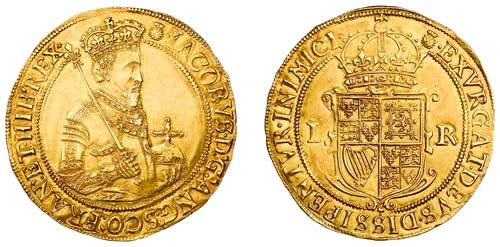
Confused. Maybe you’re meant to be.
Instead of saying “that will cost you a ¼ ounce of gold” or “that will cost you a gold sovereign coin,” or its sterling-silver coin equivalent, you simply said “that will cost you a pound” or “twenty shillings please”…
The key here is there was no price of gold or sterling-silver coin in ‘sterling-currency’
Sterling-currency had a value in gold or sterling-silver coin.
Moving along…
But gold is heavy, silver even heavier for the same value. Too heavy to carry large values on the person. And there is risk storing large quantities of gold and silver unsecured, so banks had a nice business securely storing gold. The customer got a receipt when they stored gold.5
Banks called these receipts Notes. A bank’s Notes. Being only paper they had no intrinsic value, but because these receipts were payable on demand for the gold sovereign there was value in the Note—but only as long as it could be redeemed for the gold or silver.
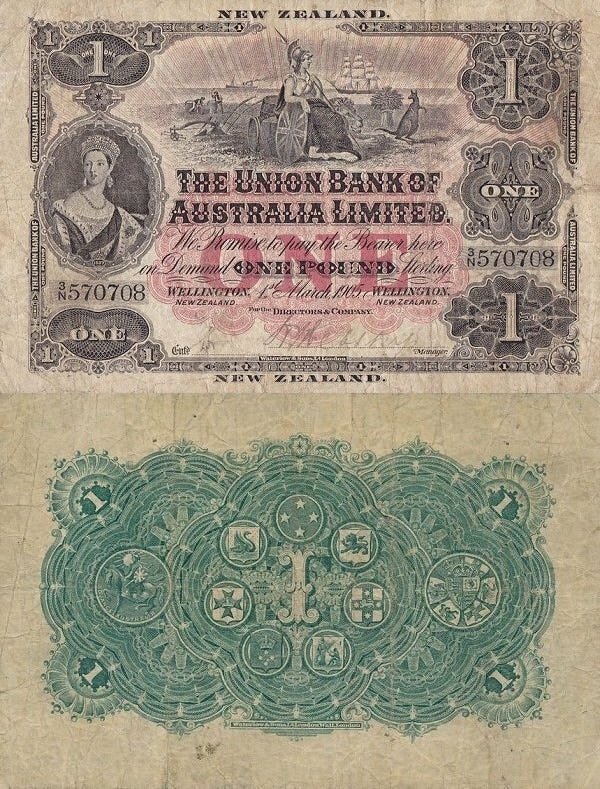
In time these receipts came to be called banknotes.
Banknotes were not legal-tender currency though it had currency. Creditors either accepted banknotes for settlement of debt, or not. If the Note wasn’t accepted the debt was still in place. If accepted, the creditor took the Note to the bank and either exchanged the Note for coin, or the Note’s sterling-value was added to the creditor’s account balance.6
It was said a gold sovereign specie coin was worth a pound-sterling, and the sovereign’s receipt, the banknote, was also worth a pound-sterling. That’s part of the language trick, because in fact
The words ‘pound-sterling’ were worth a sovereign.
The sovereign got its value from its ¼oz of gold + legal-tender status.
I’ll say again; the words, symbol and paper banknote ‘one pound-sterling’ got its value from the gold sovereign. Not vice-versa.
Then along came World War One.
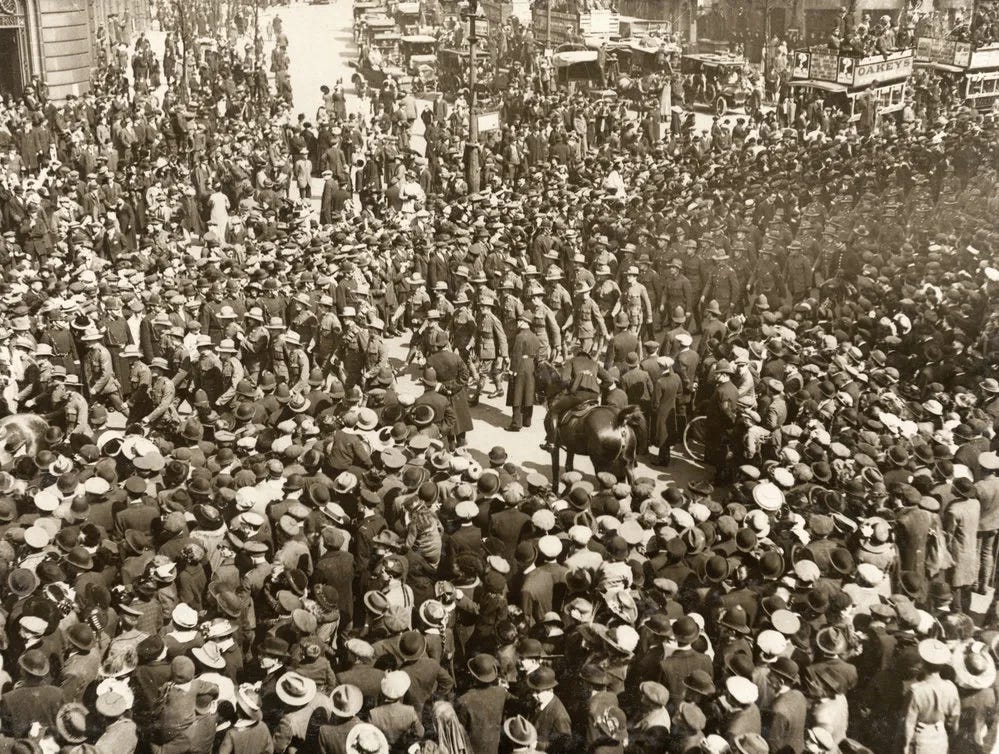
All the belligerent countries immediately changed the law to make the receipts, the banknotes, legal-tender for settlement of debt, and stopped the redemption of Notes for gold. They were no longer ‘payable on demand.’ The valueless paper receipts were disconnected from the item which gave them value. The population was told this would be temporary. That was a lie. It was permanent.
Now a pound sterling was worth—a pound sterling.
Which was worth nothing.
In 1914, in people’s minds, £1 had been a ¼oz gold sovereign coin. A bank’s Note was a receipt. But it was a trusted receipt and would itself be accepted as settlement for debt. Under cover of war, the subsequent economic chaos that resulted, lies, and time, the New Zealand population were forced to accept the Note as having the value. Over time, and with deep indoctrination from public education, the minds of New Zealanders forgot about the sovereign.
The bankers had changed the meaning and definition of a word that had meant a weight of precious metal to a word that now meant an entry in a ledger and a piece of paper.
The had swapped something physical…for its symbol.
The bankers kept the gold, and that’s how the bankers’ value trick of language was achieved.
The currency was still called sterling.
A pound sterling was still called a pound sterling.
A bank’s note was still called a banknote.
But now there was no actual physical value in the words ‘pound-sterling.’
There was no value in the value.
This is a simplification but the premise is correct, in that assuming the transaction goes ahead, and settlement of a debt is required, it will be settled in something the seller wants and can be used now or later. Transactions, settlement, value, and money are all big subjects with thousands of books and millions of words written about them. Have a look here for a few introductory links.
An item that can be used to settle debt can be said to have currency. If I swap a haircut for some tomatoes, both the haircut and tomatoes have currency. But neither are legal tender. A legal tender item is accepted everywhere in its legal jurisdiction and is called currency—but only in that jurisdiction.
“Specially refined and standardized weights“
i.e. minting into specie coin.
“was gold“
And silver and bronze/copper. Gold is rarer and because of this and the properties below is more desired and valued. Silver was used to divide gold, normally in the order of 15:1 and, because it was the most common metal in nature of the three, copper divided silver. Most of what can be said for gold can be said for silver. The advantage of gold as a monetary metal* was:
it is stable and chemically inert.
it is a malleable metal, has a high melting temperature (~1064°C) and once refined and processed all gold is essentially identical to the eye no matter its origins or age.
gold has intrinsic value because it’s a commodity and cannot be created from nothing. It requires labour and energy to produce. Because of 1., gold’s embodiment of that energy and labour is timeless, so it never has zero value.
these factors make gold the perfect means of settlement for trustless transactions, especially for international trade, and are why gold has always been one of the preferred methods to store long term wealth.
“came to be called money“
Money is not the same as currency. But it can be. Currency can be money which can be currency…this beneficial connection has been broken for over 100 years in New Zealand. See Mike Maloney’s Hidden Secrets of Money for an introduction.
* “gold as a monetary metal“
Gold has other properties which give industrial applications. More here and here.
“eventually coins“
Coinage was usually done under the auspices of an territory’s governing authority. This eliminated the need to weigh and test the purity of the metal for each transaction.
“legal-tender“
This meant if the legal-tender item was offered to settle a debt then, all things being equal, legally the debt was settled. The creditor could request payment in a different form, but had no legal recourse if another payment form was wanted.
“approximately ¼ ounce of gold“
It did change on occasion.
There were a range of other coins* made of gold and silver, of relative value based on weight, which divided the sovereign’s value. The silver shilling was an important dividing coin. A pound sterling (i.e. a gold sovereign) was valued at 20 shillings. They had the same sterling-currency value: 1 gold sovereign ⇄ 20 silver shillings.
“value“—is another way of saying desirability.
“sterling-currency“
Another noun, this time for the name of the currency system used.
C1 a market price for mined and partially processed gold (i.e. bars of a known specification; weight, purity etc.).
C2 minting into coins, shipping.
C3 legal tender means if it is offered of settlement of debt, the debt is considered settled in law. This value is known as seignorage and must be a positive number or the system fails.
This idea is referred to in a letter to the Christchurch Press in 1920, the writer referring in frustration to the continued legal tender status of banknotes ([ ] added)
How absurd then, to suppose that he [Prime Minister Massey] could give private banks the right to issue millions of one pound notes—and call them sterling!…LEGAL TENDER NOTES. PRESS, 30 OCTOBER 1920, PAGE 10
See also
* “range of other coins“
For example ½ Sovereign, Crown, ½ Crown, Florin, Shilling etc. See https://en.numista.com/catalogue/royaume-uni-7.html
Sterling silver is 92.5% silver and a base metal, normally nickel.
More on the history of the monetary unit ‘pound sterling’ here. https://www.britannica.com/money/pound-sterling
“gold“
What is said for gold applies to silver.
“bank’s notes“
Because notes were ‘payable on demand’ for gold coin, banks were required by law to have most of their notes ‘backed’ by the metal, either the coin or bullion. Because it wasn’t the bank’s property it was a liability on the balance sheet. Banks used gold as an asset, but were also legally allowed to have other assets, such as income earning government securities (i.e. interest paying government debt).
“either accepted banknotes…not“
It would have been unusual for a Note not to be accepted because it is unlikely it would have been offered unless there was already trust between the creditor and debtor.



